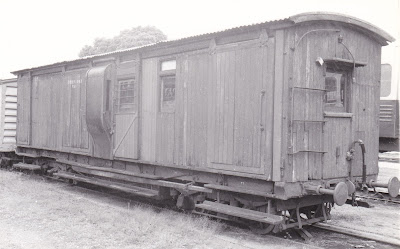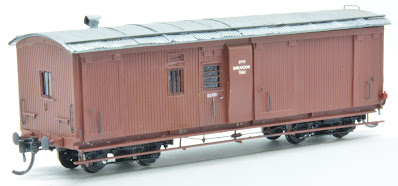Rail vehicles run great when on the rails, however from time to time for various reasons they find their way into the dirt. This is not good for any railway, often causing delays to trains on the network with many knock on effects.
To assist in a timely recovery, breakdown vans were located at various centres across the state. Most vans were located at depot stations were there was maintenance workers, fitters, wagon builders etc. Generally, locations where regular engine changes took place.
At smaller western depots,
this could be just one van containing jacks, rerailers, packing blocks/timbers,
tow ropes, “D” size first-aid box, stretchers etc. Stretchers are to washed and
tested every six months and also blankets are aired. Most had a Guard’s
compartment as most locations would not have a spare Guard’s Van available at
the time of the incident. Some may have a wood burning stove to boil the billy
and to cook meals for the breakdown gangs. Most breakdown gangs included the
local fettling gang to assist with track related matters.
At District Superintendent locations (Roma, Warwick, Maryborough, Mackay, Hughenden to name a few) extra wagons of equipment formed a small train. The vehicle on each end had Guard’s compartment to save shunting moves reversing the train or for pushing the wagons to the derailment location on the section. Gladstone for example had a CB van, CJ box wagon, FJM open wagon and another CB van. Both CB were different and not the same as a standard CB van. Both were converted from standard C wagons with the Guard’s compartment down one end. One had windows on the other end with a single side door, the other had two side doors.. Bowen and Toowoomba had similar type vans.
1962 General Appendix shows Breakdown Vans are stationed at Mayne, Gympie, Maryborough, Bundaberg, Gladstone, Rockhampton, Emerald, Alpha, Mackay, Bowen, Townsville, Charters Towers, Hughenden, Cloncurry, Innisfail, Cairns, Wooloongabba, Ipswich, Toowoomba, Warwick and Roma.
The 1989 General Appendix showed the following locations, Mayne, Maryborough, Bundaberg, Gladstone, Rockhampton, Emerald, Alpha, Jilalan, Mackay, Townsville, Hughenden, Cloncurry, Cairns, Toowoomba, Roma.
Not two vehicles except for the cranes were the same, often locally modified to suit the local gang. The plan book does show a Breakdown Van.
Wooloongabba
Cairns ?? (Power connection for other wagons on the end)
Rockhampton
Linville 2020
I’m aware of seven such vans, no two were the same. Some had end windows, others had no end windows, one had an intercar connection gangway on one end, some had additional side windows, some had a stove. Even the bogie type and wheel size varied between the vans, as did the roof. One even had electric light that could connected to adjoining wagons. Such vans were at Charleville (single vehicle only), Wooloongabba, Ipswich, Toowoomba, Maryborough, Rockhampton and may be Cairns. Some were classed CB, other were C or just Breakdown Van 9711 (BDV). There is one of these van in the Linville collection.
The more common CB with
the centre Guard’s compartment was used at a number locations including Mayne,
Gympie, and Maryborough. The other van on the Mayne train was a mail van (MV
501). The Mayne train also included car 47, this was the Western Mail dining
car before the Westlander. Bowen had a similar van to the two at Gladstone and
a CB.
Other wagons included were C, CJ, ALG class wagons, many modified with extra side door. S wagons were used at some locations to carry spare bogies, wheelset and tool boxes. . Some locations had a camp wagon included. Sunshine Express shows in 1985 the Roma Train consisted of C 5684, CJ 7130 and BDV 13928, it was withdrawn in 1986 and replaced with a standard breakdown van.
Maryborough
Maryborough
1962. (Attached to an “S” wagon, is this
part of the train).
Gympie Breakdown ALG with S wagon attached.
Gladstone FJM
wagon.
Alpha Breakdown Wagon.
The wagons were allocated a siding, mostly a dead end siding so the wagons could be grabbed quickly. At Wooloongabba the siding was between the coal stage and the engine shed. Mayne was much the same, next to the roster office and the erecting/washout sheds beside No. 2 Main Line (via Exhibition). Both were in the loco area. The Roma train was much the same near the engine shed. The Charleville van lived on the blocks on the western end of the station in the ramp road.
The wagons did not do all that much work and didn’t see the paint shop every often. The divisional train would do a trip through the division every couple of years to recover wagons pulled from the track and left lineside. Additional empty wagons would form part of these trains to convey the damage wagon recovered back to the workshops. A camp wagon for the crane operator and his crew could be included.
With the demise of wooden wagons in the mid 1980’s, BLC and CLC replaced most breakdown wagons. Around the same time the roll was move to road vehicles for quicker response and they handled smaller yard derailment. . By the late 1990’s even the size of these trucks were cut back to a small 4 x 4 truck with hydraulic equipment to drive travelling jacks. The gang consisted of a foreman and two wagon maintainers. Cranes were hired for the big jobs.
The breakdown train on
Westgate is a mix of wagons from various locations, I don’t have a complete set
of photos for one location.
Breakdown van
9711. This was the Charleville unit.
CB breakdown was modeled on
one of the Gladstone van, one of the Toowoomba vans was much the same.
C class equipment wagons
was modelled on a Maryborough wagon, similar wagons were also at Roma and
Toowoomba.
All of the above wagons were painted with PGC QGR Oxide. The roof was made from aluminium foil, etch grey primer was applied before using Vallejo Model Color # 70.862 Black Grey or Model Air # 71.072 Gunmetal. Washes and weathering pigments added to give a forgotten look of setting around in a loco shed environment.
The S wagon I didn’t have any photos, it a mix of what I could recall from the Gabba and Mayne wagons with a bit of modelling licence. The wagon was painted with Mirotone etch primer black.
All wagon were weathered
by hand using washes I made using Vallejo Model Color and Armoeall glass
cleaner. The glass cleaner is ammonia free and was purchased from SuperCheap
for about $ 12.00. All wagons were hand printed with Dullcote first, stroking
along the timber sides with the grain. No set formula was used, a couple of
spurts of cleaner with a drop of paint in a paint pallet. The CB van received
two washes, the first wash was applied by a small brush using Model Color #70.989
Sky Grey. You need to wait until the wash has dried to see if you want more. A
few hours later a wash of black (Model Color # 70.862 Black Grey) was applied
in the same manner. The C wagon only received the black wash. Breakdown Van
9711 the wash used was Model Colour # 70.983 Flat Earth.
At this point a search is
on for a smallish branch line breakdown crane. The 15 ton Krupp crane could be
a nice scratch building project. Tichy Train Group have a 120 ton Industrial
Brownhoist steam crane (kit 4010) not that much different to the QR 15 ton one.
Maybe some parts could be used from the kit, a complete new wagon frame and
bogies would be required. I guess if it is too big, it can run on the standard
gauge network.
Acknowledgements
AMRA Qld Library
Chatting with club mates, other modellers and work colleagues.
Railways of Queensland, an album of …. Volume Five
Part of the Gladstone Breakdown train. 1986. Chris Malone
Railways of Queensland, an album of …. Volume Six.
Mayne Breakdown Car 47 1963. Stan Moore
Breakdown Van BDV 13929 Maryborough 1987, J. Salomon.
The next project is the YK cattle wagon, this class of wagon had a very colourfully history on the QGR network for around 90 years.
The staff at Westgate would like to wish you all a Blessed Mary Christmas and trust 2021 will be much better than 2020.
Arthur H.



























another excellent history and collection of wagons ....
ReplyDeleteThanks Bill
Delete